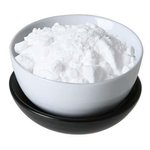Categories Raw Materials & Cosmetic Ingredients Minerals & Muds Minerals Fumed Hydrophilic Silica - Minerals 500 g Fumed Hydrophilic Silica
Product Description
A rheology control particle, an absorbent; an anticaking agent; a bulking agent; an opacifying agent; a non-surfactant suspending agent.
Appearance: Super Fine white powder with high potential for becoming airborne, wear PPE when handling and avoid inhalation.
Origin: Nature Identical. Mineral.
While Silica is naturally occurring mineral, in nature it is found bound up in forms that make it unsuitable for direct cosmetic application. Silica is most commonly found in Sand and in the soil as the crystalline mineral Quartz. Silica in the soil is utilised by plants as mono silicic acids to help them improve their drought tolerance and strength. This silica is transferred to animals (including humans) when we eat the plants and here it helps with collagen production and general growth and development. As the silica is Quartz is impossible to separate out sand (a rich source of silica) is put through several processing steps that result in the silica (Silicon Dioxide) that we are talking about here. As the resulting chemical is a pure form of what can be found in nature it is listed as 'nature identical'.
Many grades of silica exist for the cosmetic chemist to use. When these particles are made they cool to form chained aggregates rather than perfect spheres, this gives them superior thickening power over our other type of silica. Additionally, the presence of hydroxyl groups (-OH) at the surface of the silica mean it is water wettable. This is not the case for all silica particles.
Solubility: Water wettable but does not dissolve, dispersible in emulsions, oil swelling/ thickening.
Average Particle Size: This type of silica forms aggregates with an average particle size (BET Surface Area) of around 200m2/g
pH of dispersed particles in water: 3.7-4.5
Applications: Silica is useful to increase the viscosity of water-in-oil emulsions, pigmented products, dispersions and other complex mixtures. A higher than 3% level will overcome the "greasy feeling" to leave a "dry skin feel". Silica contained in foundation will absorb sweat and oils from the skin which helps the applied makeup last longer on the skin and also reduces light reflection. Silica improves the smoothness and spreading of foundations and creams.
Disclaimer
New Directions Australia Pty Ltd. does not supply food grade raw materials and therefore cannot waive GST.
Prior to use: Customers should always refer to the Material Safety Data Sheet / Specification Sheet OR the ingredients label as affixed to each product which are current at the time of supply of the product.
The information provided is for educational purposes only. Individuals receiving this information must exercise their independent judgment in determining its appropriateness for a particular purpose or use.
As the ordinary or otherwise use(s) of products is outside the control of New Directions Australia Pty Ltd., no representation or warranty, expressed or implied, is made as to the effect(s) of such use(s), (including damage or injury), or the results obtained. New Directions Australia Pty Ltd. expressly disclaims responsibility as to the ordinary or otherwise use(s). Furthermore, nothing contained herein should be considered as a recommendation by New Directions Australia Pty Ltd. as to the fitness for any use. The liability of New Directions Australia Pty Ltd. is limited to the value of the goods and does not include any consequential losses.New Directions Australia Pty Ltd. shall not be liable for any errors or delays in the content, or for any actions taken in reliance thereon.
New Directions Australia Pty Ltd. shall not be responsible for any damages resulting from use of or reliance upon this information.
The user of the product is solely responsible for compliance with all laws and regulations applying to the use of the products, including intellectual property rights of third parties.
The products contained in this website are represented in as true a manner, as photographic processes and printing will allow. The images contained in this website are for illustrative purposes only. If you have any questions with regard to how products are packaged or labeled, please contact your account manager at our Marrickville Head Office.
As the availability of ingredients and raw materials is not always certain whether due to changes in nature or otherwise, New Directions Australia Pty Ltd. reserves the right to substitute alternate ingredients/raw materials in the manufacture of its products and bases in order to maintain supply to its customers.
New Directions Australia Pty Ltd. is a wholesaler of natural skin care products and natural raw materials. If you intend to re-label our products under your own name/ brand for the purpose of on-selling or retailing, we strongly recommend that you keep up to date with constant changing labeling laws. Please visit www.accc.gov.au or www.nicnas.gov.au . New Directions Australia Pty Ltd. cannot be held responsible for consequential loss/ product recall due to incorrect labeling.
Note: Individuals receiving any information contained in this website must exercise their independent judgment in determining its appropriateness for a particular purpose or use. As with any manufacturing process, New Directions encourages small, lab-scale manufacturing for evaluation purposes prior to full commercial manufacturing.


